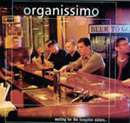Review - The Leslie 3300, page 2
by Jim Alfredson
(continued from page 1)
Hammond-Suzuki even went so far as to include adjustments for the rise and fall time and speed of each rotor. These controls are recessed and accessable only with a small Phillips screw driver. This allows you to customize all aspects of the speed of the rotors to your particular tastes, including the ramp up time and the slow down time as the length of time changing between different speeds.
AT HOME
I've been using a slightly modified vintage 122 for almost 10 years, hauling it to 99% of the gigs I play. I began using the 122 back when I was first learning organ on an old Hammond M3. I eventually got a 1958 B3, which matched the 122 perfectly. That combination can be heard on the organissimo albums Waiting For The Boogaloo Sisters... and This Is The Place and also on this clip from YouTube. When I purchased my XK System, I also bought a 1122 kit so I could use the 122 with the XK3's 11-pin output. The combination of the XK3 and 122 can be heard via organissimo's free recording of our performance at the E. Lansing Summer Solstice Jazz Festival and also on this clip from YouTube as well as our new recording Groovadelphia. The XK System / XK3 and Leslie 122 combination has been my live rig for almost two years now.
Even though I love the sound of the 122, I've been eyeing the Leslie 3300 since it came out. The higher wattage, the smaller size, and the lighter weight of the 3300 are too tempting to pass up. So you can imagine my excitement when I got the call from the freighting company that my 3300 was in town!
Fig 2.0 - My new 3300's backside, unpacked and ready to rock my living room! (click image for larger version)
I brought the 3300 home, unpacked it, and marvelled at how well-designed and visually impressive it is. The black, road-worthy coating looks great as does the silver speaker grill material covering the rotor louvres (which are really just holes at this point). The Leslie logo is display prominently on the front and the word Leslie is printed in white on the black metal mesh that protects the upper rotor. I wouldn't call it sexy, but the 3300 is definitely nice to look at.
I plugged in my XK3 with an 11-pin Leslie cable (sold separately). The 3300 uses a standard IEC power cord (included) and can be switched on manually via the power switch next to the IEC jack or it can be switched via your organ's 11pin connection, much like a traditional Leslie. When I turned on my XK3, the 3300 started spinning immediately in the slow speed. For those of us that are used to a 122 or 147, this can be a bit surprising, but is perfectly normal for the 3300. The 3300 supports the brake function, so the first thing I did before I played a note was to test the three "speeds" of the Leslie; brake (stop), chorale (slow), and tremelo (fast). I can't describe how nice it is to have all three speeds available at the touch of a button or the flip of a switch on the 3300. This is something I've been longing for since I gave up hauling my B3, which had a custom motor-control unit that provided the brake (stop) speed while using my 122.
Next I turned the 3300 up slightly and began playing. The sound was crystal clear and full. I played a bit more and then engaged the tube circuit. After playing with the tube drive and mode controls for a few minutes, and not really hearing a sound I liked, I remembered reading about changing the tube on the Yahoo XK3 users group. I decided to swap the stock tube. Lucky for me, I have a collection of NOS vintage tubes. The 3300 uses a 12AX7 type tube, but you can experiment with 12AU7, 12AT7, 12BH7, and others that match the pin-out of the 12AX7.
The first step in changing the tube is to turn the Leslie 3300 off! Remove the metal mesh screen that protects the top rotor. Unscrew a few screws and gently pry the screen until it comes out. The 12AX7 has a small wire tube guard spring that helps reduce vibration (seen a lot in guitar amps). Carefully slip that guard back off the tube. Now you can gently wiggle the tube and pull up until it comes out of the socket. Replace with a tube of your choice and turn the 3300 back on to test it. Once you find a tube you like, you can slip on the tube guard, screw the mesh screen back on, and away you go!





